The Floating Island of Fremont, Duluth’s Breakaway Township
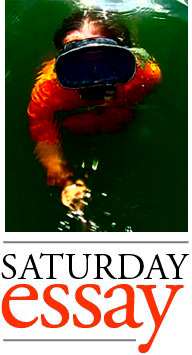 As documented in the book Duluth: An Illustrated History: “The opening of the Duluth canal proved to have a beneficial effect which its promoters had not anticipated. Currents flowing through the channel carried away a considerable amount of rotting timber and mucky islets which had infested the harbor. In fact, one of Duluth’s original townsites — Fremont — was thus swept out into Lake Superior and lost forever.”
As documented in the book Duluth: An Illustrated History: “The opening of the Duluth canal proved to have a beneficial effect which its promoters had not anticipated. Currents flowing through the channel carried away a considerable amount of rotting timber and mucky islets which had infested the harbor. In fact, one of Duluth’s original townsites — Fremont — was thus swept out into Lake Superior and lost forever.”
The Zenith City Press website confirms the account: new currents swept several floating bogs in the harbor out to sea. The largest of these islands was 1,200 feet long and 400 feet wide — larger than the largest lake vessel — and it contained the township of Fremont. It began where Rice’s Point is today, and on May 10, 1873, it passed through the canal to the open sea.
I must correct the error, often propagated, that Fremont broke up that night in rough water. The truth is, Fremont is still out there, population 299, comprised of 20 families that each own a business. I know because I have been to Fremont. I have hiked its marshes and shopped its cute, bustling downtown. I have fished off its docks. I have traded stories, dreams, and fears with Fremonters around beach campfires.
Many people have. Lake Superior is dotted with cities that Fremont has visited. I highly recommend, next time Fremont is visible on the horizon, try to get there. The Fremont music scene is a delight. And of course anyone who loves lake culture and the outdoors probably already knows about it.
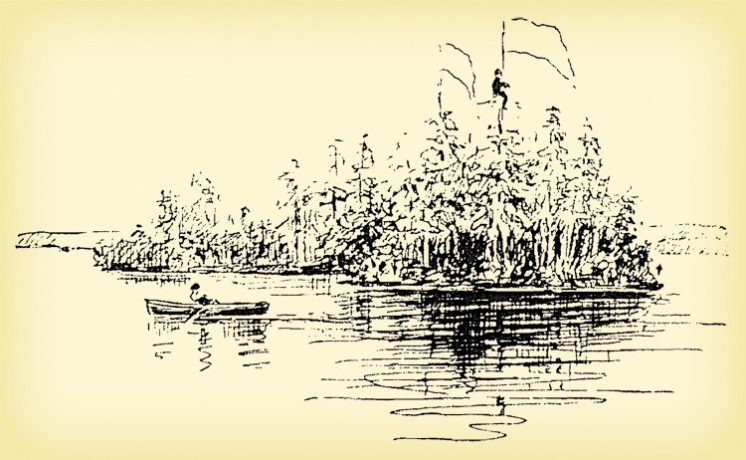
Sketch made in 1875 by Charles Johnson based on the true events of May, 1873. (Image courtesy Zenith City Press)
Stabilizing Fremont
The first thing the residents of Fremont did when they passed through the canal was to stabilize the island. Floating islands are bogs of peat and driftwood that are colonized by vegetation. Root structures provide stability and buoyancy. Mud, silt, and nutrients collect, creating soil for larger and larger trees. Fremont has a heavy canopy of trees around its downtown area which protects the smokestacks and steeples from high winds. Toward the edges of the island, one finds more low shrubs and sphagnum moss. Finally, as you approach the cattails at the water’s edge, your footing gets more spongy and springy. This is a peat mat. Caution: it’s easy to fall through.
Once on the open lake, the town elders stabilized the root structure from one end of the island to the other. That first night on Lake Superior, Fremont was bucking like a horse, and stabilization was accomplished with a supply of hemp rope from the Heustis Hardware Store, which still stands in Fremont’s historic district. Over time, upgrades were made until the pykrete (ice and wood pulp mix) superstructure was installed during Fremont’s centennial year. This requires a refrigeration plant which is the large industrial-looking building on Post Avenue between the historic and arts districts. Touring the building, I learned that the refrigeration plant keeps the pykrete frozen solid year-round via a labyrinth of ducts and tubes snaking beneath the little neighborhoods. Pykrete is stronger than steel and protects the island’s all-important root system from abrading in shallower depths, while vents allow water to circulate freely. Pykrete adds buoyancy as well as stability, effectively a keel. Many engineers consider Fremont to be a bog island on top of an artificial iceberg, a descendent of Project Habakkuk in the 1940s. Habakkuk, although never realized, was going to be an iceberg used as an aircraft carrier. This led to the invention of pykrete, but it was not until Fremont invested in the 1970s that use of this material was perfected. Fremont even has a landing strip for floatplanes, an echo of pykrete’s early dreams of being an aircraft carrier.
Steering Fremont
Besides stabilizing the floating island, the town had to solve how to steer. Fremont was at the mercy of the winds and waves, and it threatened to break up against the shore many times. This is probably the genesis of the rumor that Lake Superior destroyed Fremont on the very night of its birth, like an angry Saturn eating his child. This was avoided through luck until sails and rigging could be constructed. Fremonters rose to this challenge. They have always been a boating people. Using canvas from the Fremont Sailboat Co. (destroyed by fire in 1901), sails were installed in tall trees and masts the length of the island. By these means Fremont harnessed the wind. Two fifty-foot rudders were installed. The original oak ones are on display at the Fremont History Museum and it is worth the price of admission. Today Fremont uses barrel-type rudders which are basically engines that may be rotated. Twin steam engines were installed at the dawn of the 20th century, one at each end of the island’s longwise axis, allowing for maximum maneuverability of the not-quite symmetrical island (it is mildly crescent-shaped). The steam engines were replaced by diesel engines in the 1940s. Today Fremont’s engines are powered by sustainable peat gas.
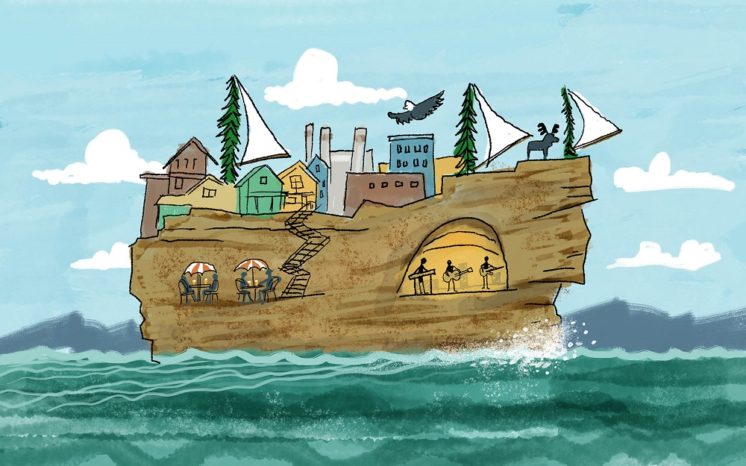
Illustration by Brian Barber depicting the true events of 2019 when Fremont Island summered a few miles off the shore of Cornucopia, Wis.
Fremont Culture
Fremont circumnavigates Lake Superior at a leisurely pace that depends on many factors. It tends to stay offshore because floating islands can be a destructive force to shorelines. As well, the superstructure and engines can become moored in water less than 30 feet deep. However, in emergencies the engines can be retracted and the morphology of the pykrete keel can be modified by repositioning the coolant tubes, allowing Fremont to dock, or to abut the shore directly. For instance, the island spent several years in the 1980s as a peninsula of Marquette, Michigan when economic conditions were mutually beneficial. Fremont docked just offshore of Grand Marais during the winter months of 2012. “Sister city” status is maintained with Saulte St. Marie, and Fremont is known to visit for semi-regular festivals.
Sometimes Fremont shows up very gradually. In 1924 it floated up to Thunder Bay so slowly that people started to think it had always been there. It left with a departure so gradual that one day no one noticed it was gone. Whenever Fremont stays a spell, it’s not just goods and services that get traded with the mainland, but mating partners. Fremonters have intermarried with communities all over Lake Superior. Some Fremonters move off the island for love or business opportunities. Conversely, some landlubbers grow attached to Fremonters and go with them when they sail away.
Some loves between Fremonters and landlubbers are tragically split by time and tide. You might love a Fremont girl from your Ashland home and think you have all the time in the world to marry her. But Fremont can be fast. The island can appear overnight, furiously trading for supplies, and then be gone by morning. So you might wake to find your Fremont girl gone. Or you might elope from Fremont to Bayfield, intending to go back the next day, only to miss your ride. Before the age of communication, this might mean you would never see Fremont again.
Fremont’s music scene is lit, if a little insular. But any night of the week at Johnson’s Grill you can listen to live music, mostly singer-songwriter stuff and cover bands. But there is a punk scene as well; perhaps the best-known band right now is the power trio Fremont Sucks, whose mix tapes may be found in cities throughout the watershed. And Fremont boasts a small but thriving hip-hop community that grew from the poetry slam scene (every Sunday night at Johnson’s).
And there are no greater outdoor enthusiasts than the residents of Fremont. Every aspect of lake culture and recreation combines with hunting and fishing to make the floating island a destination for the adventurous tourist. Hunting is decent — mostly varmints — but you’d be surprised what large animals may be found there. I once saw a moose nibbling at the willow in the municipal gardens. Fremont even boasts a Sasquatch hunter who regales visitors with tales of his encounters while trying to sell copies of his self-published book. The deep-sea fishing is unbeatable. Bald eagles make so many nests in the island’s 100 tall trees that they have become a nuisance animal — lots of opportunity for the bird-watcher.
Hikers and botanists alike marvel at the trails through Fremont’s microhabitats. The forest has picked up quite a variety over the years. One hears the wind whispering through the branches of black spruce, eastern larch, and balsam fir. The closer you get to the water the more you see low shrubs dominate like leatherleaf ferns, bog andromeda, and labrador tea. Flower watchers thrill to the flora of the marshy edge, spotting grass pink orchids, white orchids, and rose pogonias. Pitcher plants, cottongrass and other specialized biodiversity make Fremont a living laboratory. Finally, one comes to the island’s outer edge where docking structures jut from profusions of cattails and bullrushes.
Fremont Politics
Technically, Fremont maintains a legal connection to Duluth, where it is considered something of a breakaway province. There is a rivalry but normally a close diplomatic relationship. It’s not well-known but several Duluth politicians are actually natives of Fremont. This has led to murmurs in City Hall for generations that Fremont actually owns Duluth and not the other way around.
This chatter got so bad the past couple decades that Fremont is rarely spotted from Duluth any more. Occasionally one sees it on the horizon, maintaining its distance and a frosty radio silence.
Once in the spring of 1999, I spied Fremont on the horizon, and a temperature inversion created the optical illusion that it was flying. A few years ago, on a moonless summer night, I sat on one of Duluth’s rock beaches watching the stars, and I think Fremont sailed past. At first, as stars became occluded, I thought it was a thousand-foot laker hauling ore to the locks. But the lights were wrong, and I heard the distant strains of music and merriment. I didn’t hear the low hum of engines so it must have been under sail on the warm breeze. I don’t really know what it was, and Fremont likes it that way.
There are too many cases of Fremont becoming entangled with other cities in attempted land grabs, disadvantageous alliances, broken contracts, outright hucksterism, and of course xenophobia. These days Fremont prefers no contact with the outside world. There are even whispers that Fremont considers the shore communities of Lake Superior to be an existential threat. My sources have revealed to me that the Fremont deep state has been engaged in an ongoing disinformation campaign trying to convince people that its very existence is a myth. This includes retroactive deletion of all documentation in the literature, and modification of historical records by Fremont-aligned politicians in cities all across Lake Superior, including Duluth. This then must be the source of the lie that Fremont broke up the night it floated out of the canal in 1873. It is alleged that agents of the Fremont families have fanned out to intercept and redact every mention of the floating island in print. And where that fails, assassinations have been authorized. Even now I hear a noise at the door. Are those footsteps creaking up the staircase to my office? That hand! The window! The window!
[Jim Richardson has disappeared but all his essays may be found here]
Recommended Links:
Leave a Comment
Only registered members can post a comment , Login / Register Here


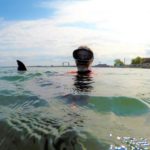

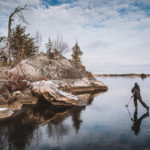









1 Comment
Bret
about 4 years ago